Virtual VOC: 10 Advantages & 7 Tips for Success

First, let’s be clear that in-person VOC has major advantages over virtual VOC (voice of customer). Want to watch for body language and non-verbal cues? Better have an in-person meeting. Want to build much stronger customer relationships? Best to get on a plane. Want a tour of the customer’s facility? Don’t ask your customer to strap on a GoPro camera.
But there are advantages of virtual VOC over in-person VOC. We won’t argue virtual VOC is better—far from it. But we don’t want you dismissing virtual voice-of-customer or overlooking ways to make it incredibly powerful. The advantages of in-person VOC are self-evident, so we’ll focus on less obvious benefits of virtual VOC. You may choose 100% in-person, 100% virtual, or a blend of the two. You get to choose.
What does virtual VOC look like? Our focus here is gaining market insights for B2B innovation through qualitative and quantitative interviews. Your moderator, note-taker and observer could sit in your conference room, while several customer contacts sit in their conference room. Or just your sales rep could meet in-person while the rest of your team is at the home office. Or if circumstances dictate, all participants could join the interview from their home offices.
If circumstances dictate, all participants could join the interview from their home offices.
All parties connect via a web-conference service, e.g. Skype, Zoom or Webex. Your virtual VOC should let customers watch their responses being recorded. New Product Blueprinting practitioners use highly-visual sticky notes and slider rating bars for Discovery and Preference interviews, respectively (see illustration).
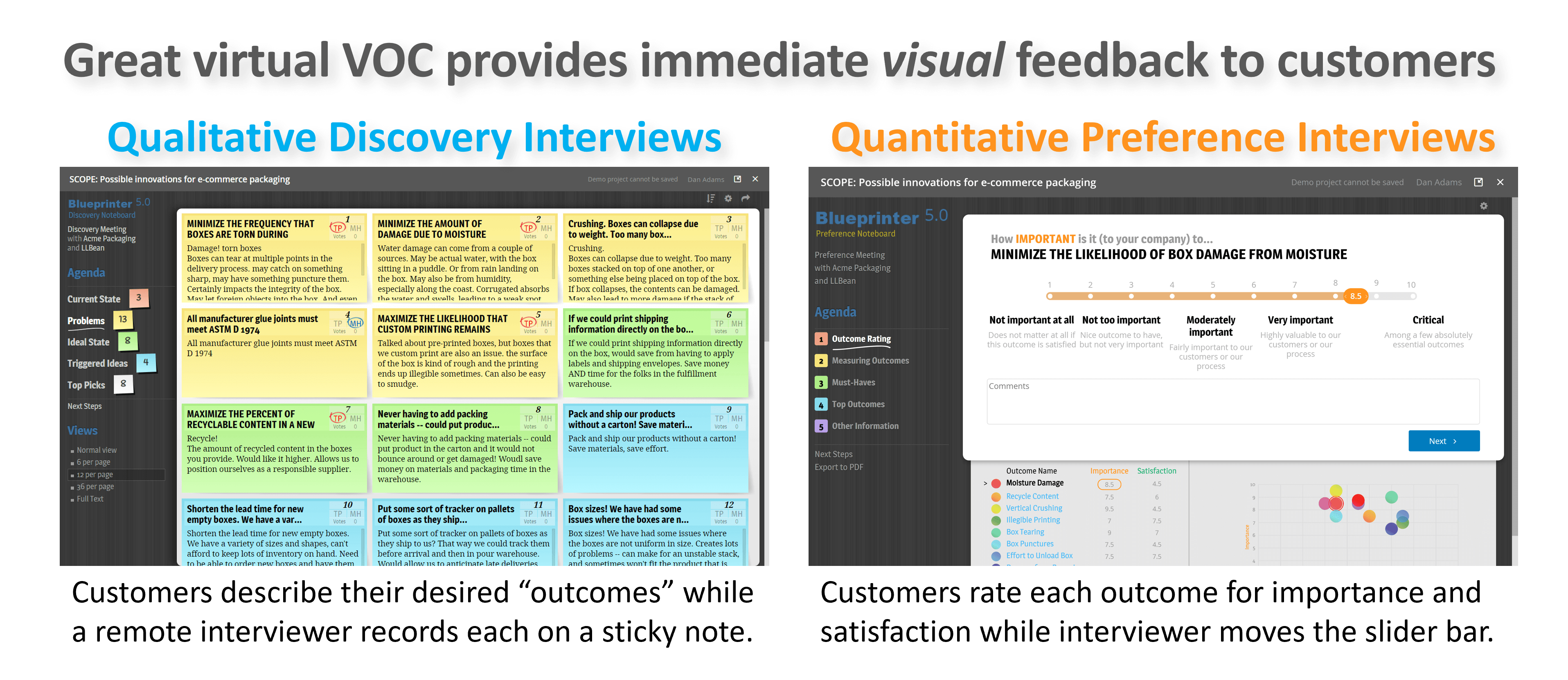
Advantage 1: Lower cost. We just had to begin with the obvious, didn’t we? Imagine you send 2-3 interviewers out on 6-10 qualitative and 6-10 quantitative interviews. You could easily spend $50,000 on travel expenses. And you’ve probably consumed 2-3 person-months of employee time, with at least 80% wasted in rental cars, security lines and cramped airplane seats. These travel expenses and non-productive personnel time go away with virtual VOC.
Advantage 2: Dispersed customer contacts: Virtual VOC is ideal if your customer’s R&D staff is in Houston, its marketing in Chicago, and so on. Or if they’re all working from home and your team is as well. Geography no longer matters. This is great for qualitative Discovery interviews, because you want to interview multiple customer contacts simultaneously so they can build off each other’s ideas. Just like brainstorming.
For quantitative Preference interviews, it’s even more important to engage all decision-influencers at the same time. Why? Imagine the operations manager rates the importance of abrasion resistance at “3” and the marketing person gives it a “9.” If you gathered their results individually, you’d have to average their responses at “6”… a terrible idea. But in a virtual session with all present, you can let them debate. You finally resolve their department-specific viewpoints with this simple question: “From the perspective of your entire company, how important is abrasion resistance?”
Advantage 3: Viewable probing tips: The key to great VOC is great probing. Practitioners of New Product Blueprinting learn the “What and Why” method of probing. The moderator asks “What” questions, such as “When does this happen?” and “Can you describe this?” Then she asks “Why” questions, like “How does this impact you?” Before moving to the next customer outcome (“What other problems are you seeing?”), the moderator asks, “Anything else we should know before we move on?” (See illustration.)

Here’s an advantage of virtual VOC over in-person VOC: You can set these tips in front of you during the interview and constantly refer to them. Yes, you’re able to do this in a face-to-face interview, but it’s much smoother in a web-conference because customers can’t see you checking your notes.
Advantage 4: Training for colleagues: What if you want to train additional employees in B2B VOC? Wouldn’t it be helpful if they could observe real VOC interviews… without travel costs… without taking much time… without disrupting the interview dynamics? Virtual VOC comes through again. Introduce them at the beginning of the interview—no one should ever eavesdrop—and then let them observe the interview. They can easily do this in a conference room with the rest of the interview team or from their home office.
What’s the ROI for “Voice of the Customer”? Read this article to learn more.
Advantage 5: Probing suggestions: If your remote interview team is meeting in a home-office conference room together, make sure it has a whiteboard or flipchart. If possible, have two observers supporting the moderator and note-taker. As the observers think of probing questions the moderator missed, they write them on the whiteboard, making sure to also record the number of the sticky note. Then your brilliant-sounding moderator can say to the customer, “I had another question about something you said on note number 2… damage due to moisture.”
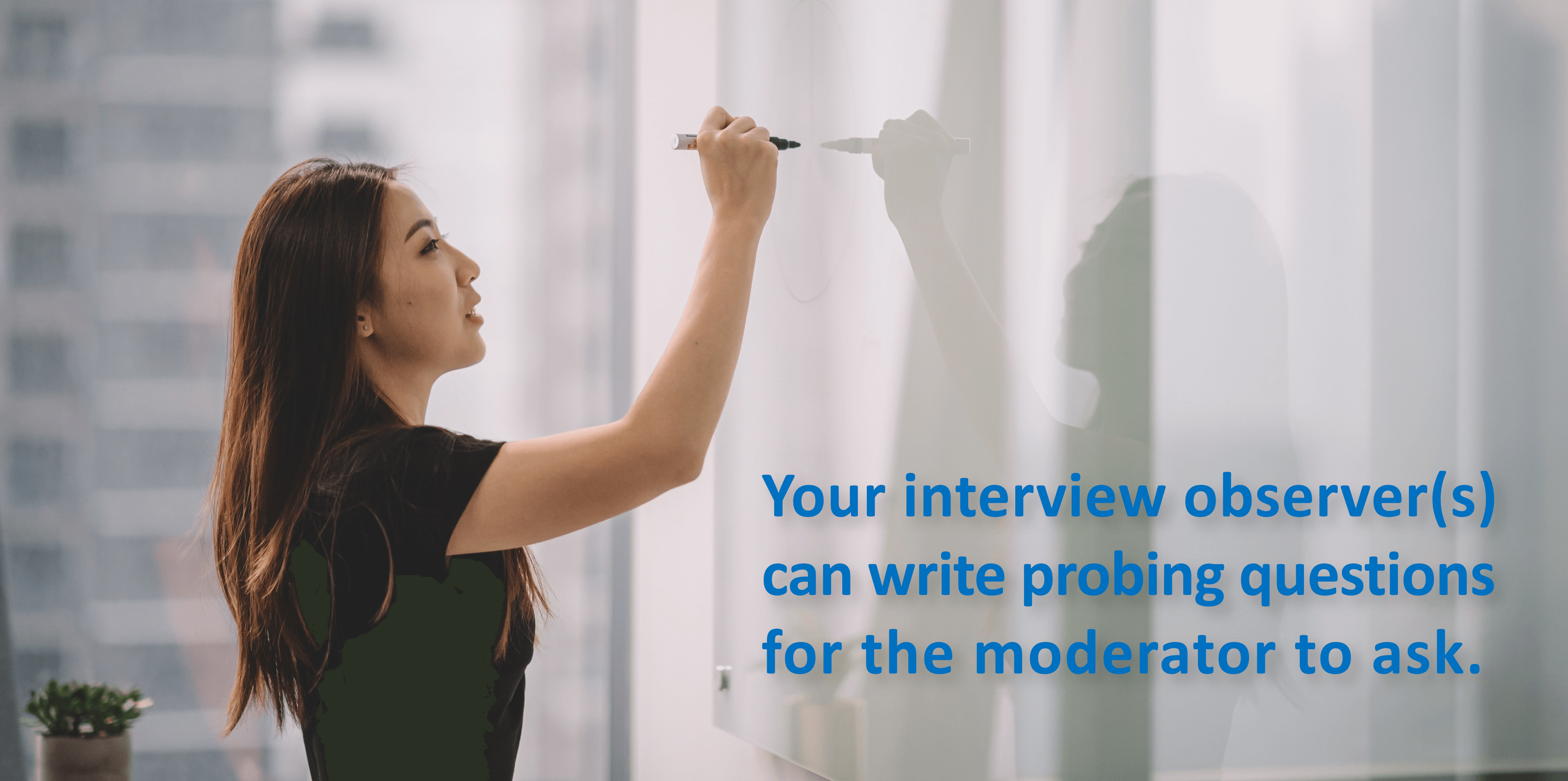
Advantage 6: Assistance for note-taker: We’ve noticed something peculiar about in-person interviewing: Customers sometimes forget about the poor note-taker. Because they’re so engaged in the discussion, they may fail to notice that the note-taker is falling behind. These dynamics change with virtual VOC. Since the only thing customers can watch is the web-conference screen, they immediately notice any lagging note-taking. We find customers are more helpful in slowing their pace, repeating points, and suggesting text changes.
Advantage 7: Rapid debriefing: After an in-person interview, the team should go to a nearby coffee shop or airport lounge and debrief: Picture the team gathered at Starbucks with the observer recommending additions and changes as the note-taker makes them in the appropriate sticky notes. The Ebbinghaus Forgetting Curve suggests we forget half of what we’ve learned in the first 24 hours. With virtual VOC, the debriefing can begin immediately after the interview. No hunting for a place to speak openly, setting up the laptop again, worrying about catching flights, etc.
Advantage 8: Easier scheduling: Sometimes the hardest part of B2B VOC is scheduling the interview. The issue usually boils down to availability and reluctance, and virtual VOC helps with both. The availability of your team can be dicey if all three of you need the same open travel day that the customer is available. But it’s easier finding a time when you’re all available for a 1-to-2 hour virtual interview.
Sometimes the hardest part of B2B VOC is scheduling the interview.
What about customer “reluctance”? Would you rather have a traveling salesman come to your home or call you on the phone? OK, perhaps a bad analogy, but you get the idea. Some customers will feel more comfortable giving up an hour or even two, if they know they can say at the end of the allotted time, “Well, I need to go to my next meeting now.”
Advantage 9: Low-impact cancellations: Face it, you’ll likely have some cancelled customer interviews. Your main contact got sick, they just had a business emergency, their CEO called an all-hands meeting, their conference room was taken over by a VP… or they simply messed up their calendars. With virtual VOC, you don’t need to limp back to the airport empty-handed at the end of a wasted day. You simply reschedule.
Advantage 10: Greater project speed: We saved our favorite for last. If your new product eventually has annual sales of $5 million with average profits, can you guess the net present value of accelerating the launch by one month? $80,000. That’s $4,000 NPV per business day. Speed matters! Virtual VOC lets you move faster with more productive scheduling, and the ability to schedule two or more interviews per day. Converting many of your in-person interviews to virtual VOC can easily trim a month or two off your timeline.
That’s $4,000 NPV per business day. Speed matters!
One more suggestion: As you finish up each Discovery interview, ask the customer for a good date and time for the Preference interview. Get it on the calendar now, and you’ll accelerate your timeline and save the hassle of setting up Preference interviews later. Use this tip with both in-person and virtual VOC and you’ll be pleased at how rapidly you finish your interviews.
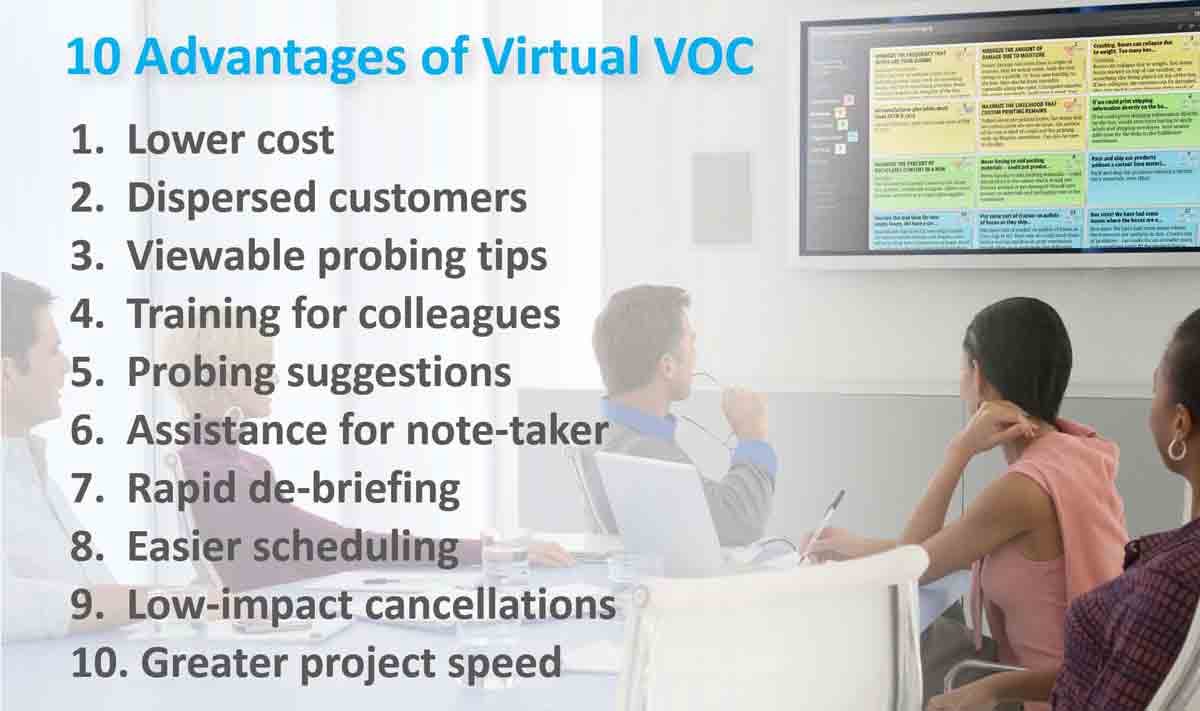
So yes, in-person voice-of-customer remains the gold standard, but virtual VOC has many advantages you can enjoy. But when should you use virtual VOC? And how do you employ it for maximum impact and benefits? Let’s explore seven tips.
Tip 1: Choose wisely. We’ve seen projects where interviews were done a) only in-person, b) only virtually, and c) with a mix of the two. You need to consider many factors to determine the right approach for your project. All else being equal, here are the factors that lean toward virtual VOC:
- Team experience: Virtual VOC is easier if your team has already mastered the dynamics of in-person interviews. (You can gain experience by practicing on your own sales reps or distributors.)
- Customer relationship: Virtual VOC works especially well when you’ve already established a relationship with a friendly customer.
- No need for tour: Consider virtual VOC after you’ve completed enough customer tours with earlier in-person interview sessions.
- Interview type: Virtual VOC works well for both Discovery and Preference interviews, but is especially productive for the latter.
- Scheduling: If you’re having a hard time coordinating calendars, consider scheduling a virtual interview.
- Travel costs: Virtual VOC eliminates your travel costs, especially helpful in difficult economies or when international interviews are needed.
- Interviewing progress: Many teams conduct their initial interviews in-person, and then move to virtual VOC. The latter is most helpful for Preference interviews when you want more 1-to-10 outcome ratings to boost your statistical confidence.
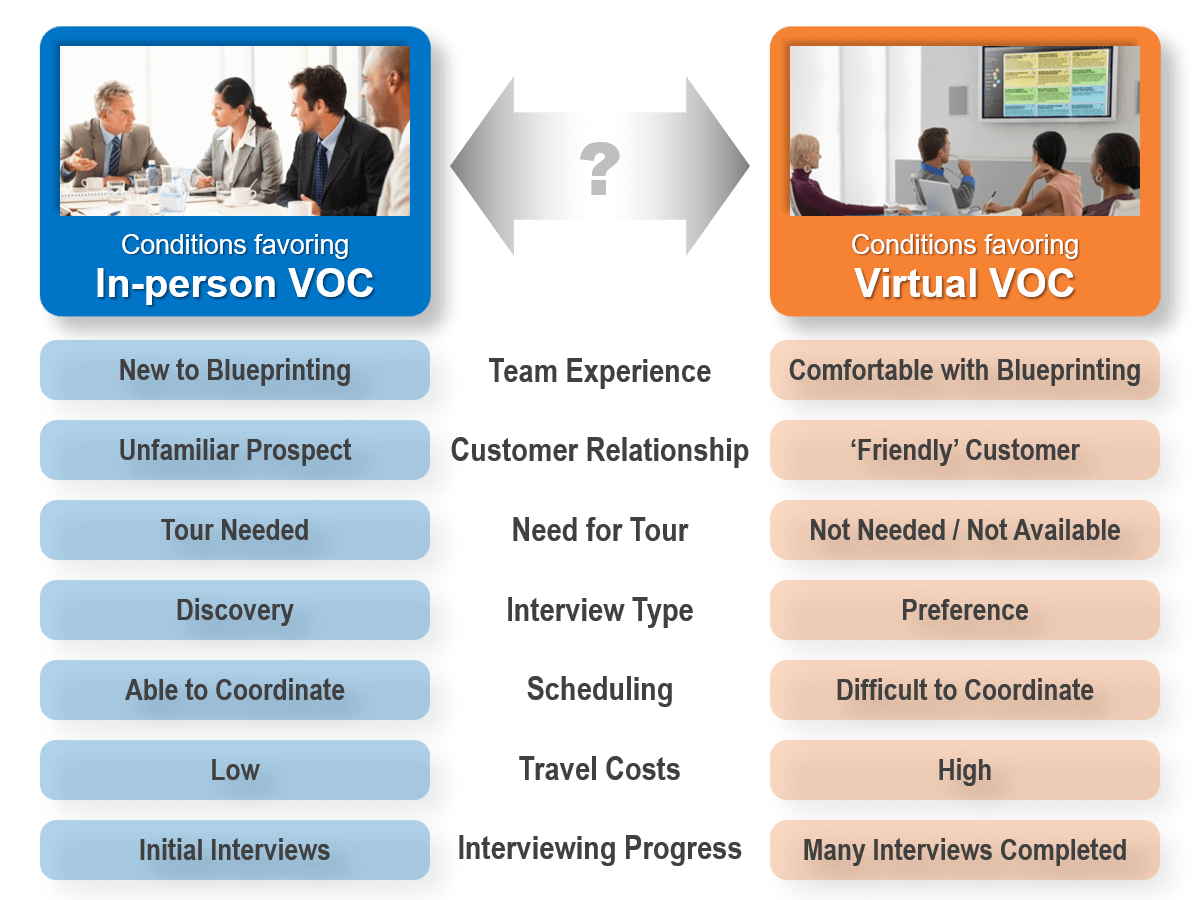
Tip 2: Build your team’s skills. Practice interviewing as a team in a “step-wise” fashion, beginning with “safe” audiences:
- Industry Experts: If you pay to interview a GLG, AlphaSights or similar industry expert, take this opportunity to improve your skills. Forget the phone-only approach and conduct a virtual web-conference interview. Ask the expert to answer your questions as customers in the target market would likely reply.
- Sales colleagues: Set up a web-conference and ask them to respond “as the customer would.” Beside great practice, you’ll get your sales team more comfortable with these interviews, so they’ll be more effective in requesting them.
- Internal departments: Do you have others in your company with experience in this area, perhaps based on their prior work at another company? These could be helpful interview candidates.
- Distributors: If you use distributors, interview them before the “real” customers using your product. It will be good practice for you, let’s you understand how much insight they have, and turns your distributors into more effective partners.
- Smaller, safer customers: If you have smaller customers, start your interviews with them. Also, consider interviewing “friendly” customers who will overlook your lack of “smoothness” until you get comfortable with this type of interviewing.
- Larger, high-stakes customers: By the time you “build up” to these customers with prior practice, you and your team-mates will be one, highly-polished, impressive interviewing team!
Tip 3: Prepare your customer. If you’re looking for great virtual VOC, you’ll need to carefully prepare your interviewees:
- Work hard to get several customer contacts joining each interview: You’ll get more valuable information this way, and raise the overall energy level.
- Make sure all customer attendees—not just your main contact—receive a copy of the meeting agenda.
- Don’t call this an “interview” (which can have a bad connotation). Instead, call it a Discovery or Preference “meeting” or “session.”
- Provide the WIIFM (“what’s in it for me”) to customers. For instance, tell them you could be a source of open innovation for them. But to do this, you first must understand their needs.
- Ask your main contact to join the meeting 10-15 minutes early in their conference room, so you can get the web-conference working and do a sound check.
Tip 4: Make this enjoyable for customers. With a little effort, your virtual VOC will engage and energize your customers. Here’s how:
- Use your webcams so they can see your smiling faces… especially at the beginning of the session. At a minimum, display photos of yourselves.
- At the onset, go around the room with introductions. Start with your team members and keep it light.
- Why not order some food to be delivered from a local restaurant, such as Panera? (Check with your main contact first.)
- Use lots of visual cues during the meeting. If you’re using Discovery sticky notes, refer to the note number so all can follow along. Or if you want to draw their attention to some text, be sure to highlight it.
Tip 5: Probe like a pro. Getting the right customer contacts into your interview is the most important part of strong VOC. After that, top-flight probing separates great VOC from mediocre VOC. Go for “great” with these tips:
- Put your probing tips in front of you during virtual VOC. As discussed in Advantage #3, you can continue referring to your “what and why” probing questions throughout the interview.
- If your interview team is meeting in one conference room, have your observer(s) write good probing questions on a whiteboard, as suggested in Advantage #5.
- Invite VOC “trainees” to your virtual VOC so they get first-hand experience. By the time they start conducting their own interviews, they’ll be past the novice stage. (See Advantage #4.)
Top-flight probing separates great VOC from mediocre VOC.
Tip 6: Consider sending a local colleague. Do you have a sales rep in the customer’s geographic area that could represent your company? They can be helpful in several ways:
- Have your sale professional arrive early and help with meeting setup. Then everything is ready to go when the first customer walks in the conference room.
- Having your colleague in the customer conference room for greetings and introductions is a great ice-breaker.
- Your local person can be your primary interview “observer.” They should watch body language, monitor signs of impatience, notice if one person isn’t getting a chance to speak, etc.
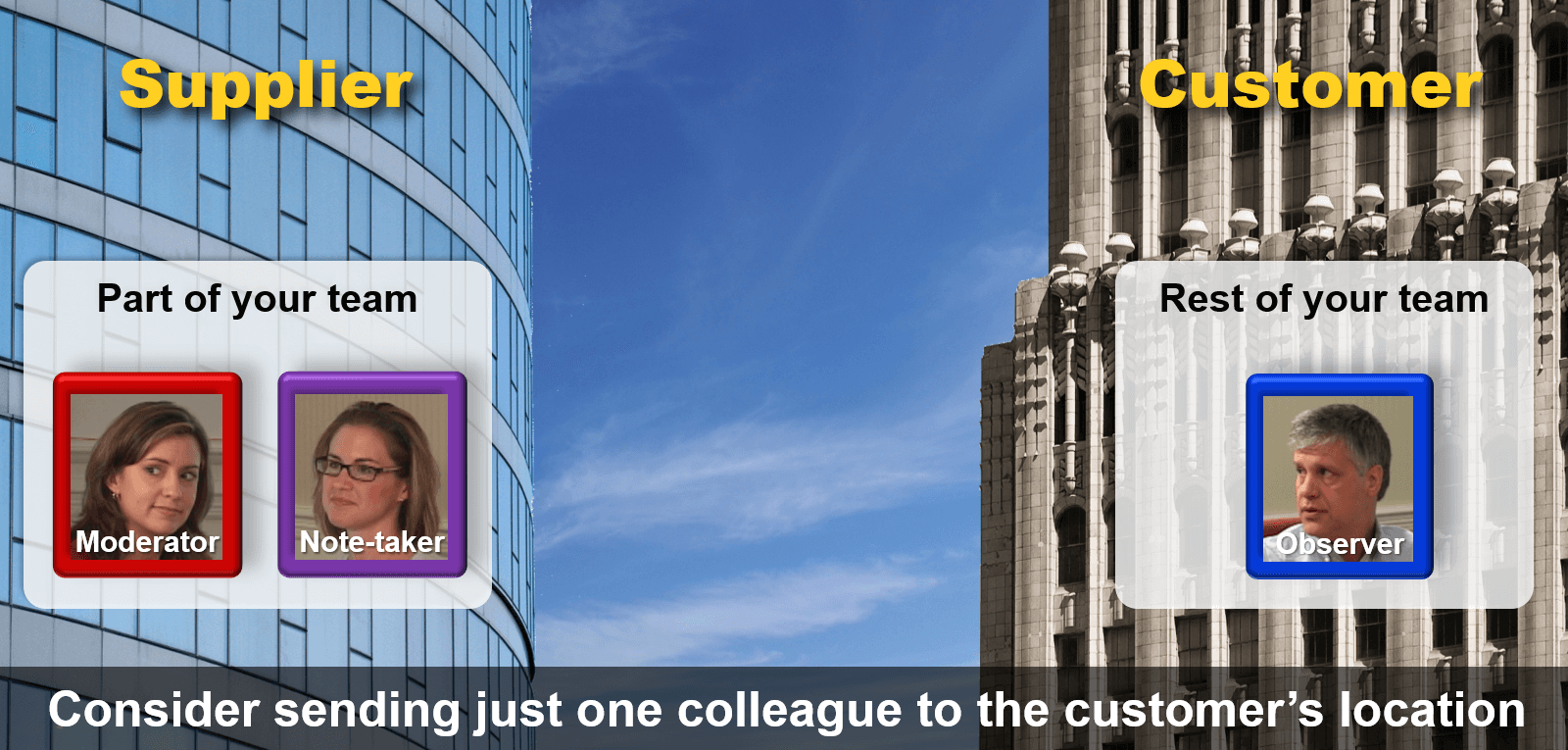
Tip 7: Ensure strong follow-up. This is true for in-person as well as virtual VOC… but it bears mentioning. Be sure to follow-up after your interview. The worst possible outcome of a B2B interview is your customer saying this: “Yes, that company did a nice interview… but then we never heard from them again.” Consider these simple approaches:
- Ask the customer how they’d like to be updated… and do it
- Make a phone call or send an e-mail to say thank you
- Send a PDF of the interview notes & ask them for updates
- Call them to ask for help in clarifying some points
- Share summarized industry results of your interviews
- Call or e-mail to indicate that your project is still active
- Have your sales rep provide them with periodic updates
- Share your new product prototypes with the customer
Getting started with virtual VOC…
It’s not hard to turn your company into a virtual VOC powerhouse. The first step is mastering the fundamentals of B2B-optimized interviewing—nearly all of which apply to both in-person and virtual voice-of-customer. Here are some steps you can take to get started:
- Check out this short video to see how Discovery and Preference interviews are done in-person. You’ll notice how easy the “jump” to virtual VOC would be.
- Download this e-book, Reinventing VOC for B2B, which is loaded with tips for B2B-optimized VOC.
- Join us at one of our open New Product Blueprinting workshops. Details are at blueprintingworkshop.com
- Contact us for a consultation. Don’t be surprised if we suggest a short virtual web-conference.
We know that better VOC leads to better customer insight… which leads to better innovation… which leads to better growth. Whether you get on an airplane or work from home… this is our wish for you.
View video of a Voice-of-Customer simulation using New Product Blueprinting
USA India Pharm: USA India Pharm – top 10 pharmacies in india
USA India Pharm: india pharmacy – top 10 pharmacies in india
UsaIndiaPharm USA India Pharm USA India Pharm
UsaIndiaPharm: pharmacy website india – UsaIndiaPharm
Your style is really unique compared to other people I’ve read stuff from. Many thanks for posting when you’ve got the opportunity, Guess I’ll just bookmark this blog.
Can you be more specific about the content of your article? After reading it, I still have some doubts. Hope you can help me.
UsaIndiaPharm: USA India Pharm – USA India Pharm
UsaIndiaPharm: india pharmacy – buy prescription drugs from india
online shopping pharmacy india indian pharmacy paypal top 10 pharmacies in india
UsaIndiaPharm: UsaIndiaPharm – indian pharmacy paypal
indian pharmacy: USA India Pharm – USA India Pharm
india online pharmacy: top 10 pharmacies in india – pharmacy website india
Online medicine order: india pharmacy – best online pharmacy india
USA India Pharm UsaIndiaPharm UsaIndiaPharm
reading this weblog’s post to be updated daily.
online shopping pharmacy india: UsaIndiaPharm – india pharmacy
UsaIndiaPharm: reputable indian pharmacies – indianpharmacy com
best india pharmacy indian pharmacy UsaIndiaPharm
UsaIndiaPharm: indian pharmacy paypal – best india pharmacy
USA India Pharm: top 10 online pharmacy in india – top online pharmacy india
UsMex Pharm: best online pharmacies in mexico – usa mexico pharmacy
Us Mex Pharm: usa mexico pharmacy – usa mexico pharmacy
Us Mex Pharm usa mexico pharmacy UsMex Pharm
at web, except I know I am getting familiarity all the time by reading thes pleasant posts.|Fantastic post. I will also be handling some of these problems.|Hello, I think this is a great blog. I happened onto it;) I have bookmarked it and will check it out again. The best way to change is via wealth and independence. May you prosper and never stop mentoring others.|I was overjoyed to find this website. I must express my gratitude for your time because this was an amazing read! I thoroughly enjoyed reading it, and I’ve bookmarked your blog so I can check out fresh content in the future.|Hi there! If I shared your blog with my Facebook group, would that be okay? I believe there are a lot of people who would truly value your article.|منشور رائع. سأتعامل مع بعض هذه|
USMexPharm: buying prescription drugs in mexico online – certified Mexican pharmacy
USMexPharm: mexican pharmacy – purple pharmacy mexico price list
usa mexico pharmacy: USMexPharm – UsMex Pharm
usa mexico pharmacy certified Mexican pharmacy buying from online mexican pharmacy
USMexPharm: usa mexico pharmacy – Us Mex Pharm
Mexican pharmacy ship to USA: USMexPharm – purple pharmacy mexico price list
UsMex Pharm: USMexPharm – mexican pharmacy
usa mexico pharmacy usa mexico pharmacy certified Mexican pharmacy
Mexican pharmacy ship to USA: Mexican pharmacy ship to USA – mexican pharmacy
usa mexico pharmacy: UsMex Pharm – UsMex Pharm
You should take part in a contest for one of the finest sites on the web. I will recommend this blog!
usa mexico pharmacy: USMexPharm – certified Mexican pharmacy
USMexPharm: mexican pharmacy – Us Mex Pharm
Us Mex Pharm UsMex Pharm usa mexico pharmacy
Хотите погрузиться в мир захватывающего азарта? Тогда добро пожаловать в Aurora Casino – место, где выигрыши становятся реальностью! https://aurora-world.top/ и испытайте настоящие эмоции от игры!
Почему стоит выбрать Aurora Casino?
Лучшие слоты и настольные игры – эксклюзивные live-игры с настоящими дилерами.
Щедрая бонусная программа – приветственные бонусы, фриспины, кэшбэк.
Моментальные выплаты – оперативное зачисление выигрышей.
Комфортная игровая платформа – поддержка всех устройств и платформ.
Профессиональная поддержка – онлайн-чат, e-mail, горячая линия.
Присоединяйтесь к Aurora Casino и получите возможность выигрывать каждый день!
usa mexico pharmacy: usa mexico pharmacy – Us Mex Pharm
mexico pharmacies prescription drugs: Mexican pharmacy ship to USA – USMexPharm
casino siteleri 2025 casino siteleri slot casino siteleri casinositeleri1st.shop
lisansl? casino siteleri: casino siteleri 2025 – deneme bonusu veren siteler casinositeleri1st.com
sweet bonanza oyna: sweet bonanza 1st – sweet bonanza sweetbonanza1st.shop
sweet bonanza giris: sweet bonanza giris – sweet bonanza demo sweetbonanza1st.shop
sweet bonanza oyna sweet bonanza oyna sweet bonanza siteleri sweetbonanza1st.com
I’d must talk with you here. Which is not some thing I do! I spend time reading an article that could get people to feel. Also, appreciate your allowing me to comment!
https://sweetbonanza1st.shop/# sweet bonanza
sweet bonanza slot: sweet bonanza siteleri – sweet bonanza giris sweetbonanza1st.shop
You did an excellent job with this post! Your talent for making complex ideas relatable is impressive. The examples you provided really brought your points to life. Thank you for all the effort you put into your writing—it’s truly appreciated!
sweet bonanza yorumlar: sweet bonanza giris – sweet bonanza siteleri sweetbonanza1st.shop
sweet bonanza siteleri: sweet bonanza demo – sweet bonanza siteleri sweetbonanza1st.shop
en iyi oyun siteleri: lisansl? casino siteleri – guvenilir casino siteleri casinositeleri1st.com
sweet bonanza yorumlar sweet bonanza oyna sweet bonanza yorumlar sweetbonanza1st.com
sweet bonanza siteleri: sweet bonanza slot – sweet bonanza demo sweetbonanza1st.shop
sweet bonanza: sweet bonanza siteleri – sweet bonanza oyna sweetbonanza1st.shop
welches online casino: casibom resmi – gГјvenilir casino casibom1st.com
casino siteleri casino siteleri deneme bonusu veren siteler casinositeleri1st.shop
sweet bonanza demo: sweet bonanza yorumlar – sweet bonanza slot sweetbonanza1st.shop
tГјrkiye bahis siteleri: casibom mobil giris – glГјcksspiel internet casibom1st.com
https://sweetbonanza1st.shop/# sweet bonanza slot
kaГ§ak bahis siteleri bonus veren: casibom – bilinmeyen siteler casibom1st.com
sweet bonanza siteleri: sweet bonanza giris – sweet bonanza siteleri sweetbonanza1st.shop
100 tl bonus veren bahis siteleri casibom resmi online kumar siteleri casibom1st.shop
internet kumar siteleri: casibom guncel giris – pronet giriЕџ casibom1st.com
siteler bahis: casibom resmi – en iyi bet siteleri casibom1st.com
yeni siteler: casibom – vidobet giriЕџ 2025 casibom1st.com
lisansl? casino siteleri lisansl? casino siteleri deneme bonusu veren siteler casinositeleri1st.shop
sweet bonanza slot: sweet bonanza demo – sweet bonanza siteleri sweetbonanza1st.shop
casino siteleri 2025: casino siteleri – lisansl? casino siteleri casinositeleri1st.com
bahis oyunlarД±: casibom giris – mobil bahis siteleri casibom1st.com
lisansl? casino siteleri casino siteleri gГјzel siteler casinositeleri1st.shop
Clom Fast Pharm: cost generic clomid for sale – Clom Fast Pharm
zestril 20 mg tablet: where to buy lisinopril online – lisinopril 40mg
prednisone cream rx: Pred Pharm Net – Pred Pharm Net
Lisin Express: Lisin Express – Lisin Express
ZithPharmOnline zithromax cost canada ZithPharmOnline
Pred Pharm Net: Pred Pharm Net – prednisone 50 mg tablet canada
ZithPharmOnline: ZithPharmOnline – generic zithromax online paypal
Clom Fast Pharm can i get generic clomid without dr prescription where to get cheap clomid price
can i buy generic clomid without rx: get generic clomid price – cost of cheap clomid pill
ZithPharmOnline: ZithPharmOnline – cheap zithromax pills
Lisin Express: п»їbuy lisinopril 10 mg uk – Lisin Express
zithromax tablets: zithromax generic price – how to buy zithromax online
Clom Fast Pharm Clom Fast Pharm cheap clomid
buy 10 mg prednisone: prednisone for sale without a prescription – prednisone 5mg over the counter
https://predpharmnet.shop/# prednisone 20mg price in india
Lisin Express: Lisin Express – lisinopril 10 mg pill
AmOnlinePharm: AmOnlinePharm – AmOnlinePharm
can you get clomid now get cheap clomid without rx where can i get cheap clomid without prescription
how much is zithromax 250 mg: ZithPharmOnline – ZithPharmOnline
prednisone 1 mg tablet: Pred Pharm Net – Pred Pharm Net
Pred Pharm Net: prednisone for sale online – prednisone rx coupon
order amoxicillin online uk: AmOnlinePharm – where can you get amoxicillin
Clom Fast Pharm buying generic clomid no prescription can i get generic clomid without dr prescription
zithromax antibiotic without prescription: zithromax generic price – ZithPharmOnline
buy prednisone online uk: Pred Pharm Net – Pred Pharm Net
Pred Pharm Net: Pred Pharm Net – price of prednisone 5mg
where buy cheap clomid without prescription Clom Fast Pharm Clom Fast Pharm
Pred Pharm Net: Pred Pharm Net – Pred Pharm Net
best online pharmacies in mexico: purple pharmacy mexico price list – mexican border pharmacies shipping to usa
best online pharmacies in mexico: medicine in mexico pharmacies – mexican drugstore online
india online pharmacy buy prescription drugs from india buy medicines online in india
canadian pharmacy store: GoCanadaPharm – canadian family pharmacy
buy canadian drugs: go canada pharm – canada pharmacy world
canadian pharmacy online go canada pharm canadian pharmacies comparison
reputable indian pharmacies: www india pharm – Online medicine order
buying from online mexican pharmacy: п»їbest mexican online pharmacies – mexican border pharmacies shipping to usa
canadian drugs: canadian pharmacy – canadian pharmacy online
canadian pharmacy reviews: go canada pharm – canadian pharmacy reviews
www india pharm pharmacy website india www india pharm
reliable canadian online pharmacy: real canadian pharmacy – canadian neighbor pharmacy
best canadian online pharmacy: GoCanadaPharm – canadian family pharmacy
india pharmacy mail order: www india pharm – india pharmacy
pharmacies in mexico that ship to usa mexico pharmacies prescription drugs Agb Mexico Pharm
www india pharm: online shopping pharmacy india – www india pharm
Agb Mexico Pharm: medicine in mexico pharmacies – Agb Mexico Pharm
mexico drug stores pharmacies: mexican rx online – mexican border pharmacies shipping to usa
safe canadian pharmacy northwest pharmacy canada canada drugs online
www canadianonlinepharmacy: GoCanadaPharm – canadian pharmacy world
buying from online mexican pharmacy: Agb Mexico Pharm – Agb Mexico Pharm
https://agbmexicopharm.com/# п»їbest mexican online pharmacies
Agb Mexico Pharm: Agb Mexico Pharm – Agb Mexico Pharm
canada cloud pharmacy legitimate canadian mail order pharmacy maple leaf pharmacy in canada
Agb Mexico Pharm: reputable mexican pharmacies online – mexico drug stores pharmacies
Apotheek online bestellen: ApotheekMax – ApotheekMax
Добро пожаловать в Zooma Casino – лучшее онлайн-казино для любителей острых ощущений! Здесь вас ждут захватывающие игровые автоматы от ведущих разработчиков. https://zooma-play.buzz/ и погрузитесь в мир высоких выигрышей!
Какие уникальные возможности вас ждут?
Популярные слоты с бонусными раундами.
Эксклюзивные акции на депозиты и ставки.
Гарантированные выигрыши без задержек и комиссий.
Современный интерфейс на любых устройствах.
Поддержка 24/7 работают круглосуточно.
Начните свое игровое приключение чтобы насладиться игрой на максимуме!
http://apotekonlinerecept.com/# apotek online
Kamagra Gel kamagra kamagra
Online apotheek Nederland met recept: Online apotheek Nederland zonder recept – online apotheek
https://apotheekmax.com/# Apotheek online bestellen
Apoteket online: apotek online recept – apotek pa nett
Apotek hemleverans recept apotek online Apotek hemleverans idag
https://apotheekmax.com/# ApotheekMax
Kamagra kaufen: kamagra – Kamagra Oral Jelly
http://apotekonlinerecept.com/# Apotek hemleverans idag
Kamagra Original: Kamagra kaufen – Kamagra Gel
apotek pa nett Apotek hemleverans recept apotek online recept
Kamagra kaufen ohne Rezept: Kamagra Oral Jelly kaufen – Kamagra Oral Jelly kaufen
Kamagra Oral Jelly: Kamagra Gel – Kamagra Oral Jelly
http://apotheekmax.com/# Apotheek online bestellen
Kamagra kaufen Kamagra kaufen ohne Rezept Kamagra Original
Apotek hemleverans idag: apotek pa nett – apotek pa nett
Мечтаете о щедрых выигрышах? Добро пожаловать в Jetton Casino – инновационное казино, где представлен широкий каталог слотов. https://jetton-arena.top/ и почувствуйте настоящий драйв!
В чем наши преимущества?
Популярные развлечения – игры от ведущих провайдеров.
Промо-предложения – программа лояльности для постоянных игроков.
Безопасные транзакции – операции под защитой SSL-шифрования.
Удобная навигация – адаптивный дизайн без ограничений.
Дружелюбные операторы – быстрое решение любых вопросов.
Начните выигрывать уже сегодня и играйте с комфортом!
https://apotheekmax.com/# ApotheekMax
Kamagra Original: kamagra – Kamagra Oral Jelly
This design is wicked! You obviously know how to keep
a reader amused. Between your wit and your videos, I was almost moved to start my
own blog (well, almost…HaHa!) Fantastic job. I really enjoyed what you had to say, and more than that, how you
presented it. Too cool!
https://kamagrapotenzmittel.shop/# Kamagra Gel
Kamagra online bestellen Kamagra Oral Jelly kamagra
Kamagra Oral Jelly kaufen: Kamagra Original – Kamagra Original
https://apotekonlinerecept.shop/# Apoteket online
Kamagra Original: Kamagra online bestellen – Kamagra kaufen
Beste online drogist ApotheekMax Betrouwbare online apotheek zonder recept
http://kamagrapotenzmittel.com/# Kamagra kaufen ohne Rezept
Kamagra Oral Jelly kaufen: Kamagra online bestellen – Kamagra Oral Jelly kaufen
http://kamagrapotenzmittel.com/# kamagra
Kamagra online bestellen Kamagra Oral Jelly Kamagra online bestellen
Kamagra kaufen ohne Rezept: Kamagra kaufen ohne Rezept – Kamagra Oral Jelly
пин ап казино зеркало – пин ап казино
KamagraKopen.pro kamagra gel kopen kamagra pillen kopen
пин ап вход: https://pinupkz.life/
пин ап зеркало – пин ап казино
пинап казино: https://pinupkz.life/
пин ап казино официальный сайт – пин ап
Cialis 20mg price Tadalafil price Buy Tadalafil 10mg
пин ап зеркало – пин ап вход
пин ап казино официальный сайт: https://pinupkz.life/
pinup 2025 – пин ап казино зеркало
пин ап казино официальный сайт: https://pinupkz.life/
cialis without a doctor prescription Cialis without a doctor prescription TadalafilEasyBuy.com
pinup 2025 – пин ап казино официальный сайт
пин ап казино: https://pinupkz.life/
пин ап – пин ап
пин ап казино зеркало: https://pinupkz.life/
pinup 2025 – пин ап зеркало
Kamagra Kamagra Kopen kamagra kopen nederland
пинап казино: https://pinupkz.life/
пин ап зеркало – пин ап казино
kamagra pillen kopen: Kamagra Kopen Online – kamagra gel kopen
https://generic100mgeasy.com/# Generic100mgEasy
cialis without a doctor prescription Tadalafil Easy Buy TadalafilEasyBuy.com
cialis without a doctor prescription: Tadalafil Easy Buy – Cialis 20mg price in USA
https://kamagrakopen.pro/# Kamagra
https://tadalafileasybuy.shop/# TadalafilEasyBuy.com
Kamagra Kopen Online: kamagra 100mg kopen – kamagra 100mg kopen
Kamagra Kopen Online kamagra pillen kopen KamagraKopen.pro
https://tadalafileasybuy.shop/# Tadalafil Easy Buy
kamagra 100mg kopen: kamagra pillen kopen – Officiele Kamagra van Nederland
https://kamagrakopen.pro/# Officiele Kamagra van Nederland
KamagraKopen.pro kamagra 100mg kopen Kamagra Kopen Online
Generic 100mg Easy: Generic100mgEasy – Generic100mgEasy
http://generic100mgeasy.com/# Generic100mgEasy
Generic 100mg Easy: sildenafil online – buy generic 100mg viagra online
kamagra pillen kopen kamagra kopen nederland kamagra 100mg kopen
http://generic100mgeasy.com/# Generic100mgEasy
Generic 100mg Easy: Generic 100mg Easy – buy generic 100mg viagra online
TadalafilEasyBuy.com cialis without a doctor prescription TadalafilEasyBuy.com
buy generic 100mg viagra online: Cheap generic Viagra – Generic 100mg Easy
https://kamagrakopen.pro/# Kamagra Kopen
Kamagra Kopen: kamagra kopen nederland – kamagra kopen nederland
https://kamagrakopen.pro/# kamagra pillen kopen
Generic100mgEasy Generic 100mg Easy buy generic 100mg viagra online
Generic100mgEasy: Generic100mgEasy – Generic100mgEasy
https://tadalafileasybuy.com/# TadalafilEasyBuy.com
safe canadian pharmacy legitimate canadian pharmacies online online canadian drugstore
https://interpharmonline.shop/# vipps approved canadian online pharmacy
global pharmacy canada
India Med Fast: IndiaMedFast – online medicine shopping in india
Can you be more specific about the content of your article? After reading it, I still have some doubts. Hope you can help me. https://www.binance.com/zh-TC/register?ref=VDVEQ78S
https://indiamedfast.shop/# IndiaMedFast.com
recommended canadian pharmacies
Mexican Pharm Inter: Mexican Pharm Inter – reliable mexican pharmacies
online pharmacy india india online pharmacy store India Med Fast
https://indiamedfast.shop/# buying prescription drugs from india
is canadian pharmacy legit
cheapest online pharmacy india: india pharmacy without prescription – cheapest online pharmacy india
https://indiamedfast.shop/# india online pharmacy store
canadian pharmacy antibiotics
buying prescription drugs from india lowest prescription prices online india online medicine shopping in india
india online pharmacy store: online medicine shopping in india – online medicine shopping in india
https://mexicanpharminter.shop/# mexican drug stores online
buy prescription drugs from canada cheap
india online pharmacy store: online pharmacy india – India Med Fast
https://mexicanpharminter.com/# mexican pharmacy online store
canadian pharmacy oxycodone
mexican pharmacy online order Mexican Pharm Inter Mexican Pharm Inter
Mexican Pharm International: Mexican Pharm International – reliable mexican pharmacies
http://indiamedfast.com/# buying prescription drugs from india
best canadian online pharmacy
canadian online drugstore: legitimate canadian pharmacies online – best canadian pharmacy
canada pharmacy online fda approved canadian online pharmacies canadian pharmacy oxycodone
http://indiamedfast.com/# IndiaMedFast
canadianpharmacymeds
alo789 dang nh?p: alo 789 dang nh?p – dang nh?p alo789
Your article helped me a lot, is there any more related content? Thanks!